Instructional Series
Welcome to the English medium literacy instructional series teaching and learning resources for years 1 to 8.

- Gold
- Purple
- Magenta
- Yellow
- 3
- 2
- 4
- 1
- 6
- 4
- 5
- 8
- 7
- 3
- 1
- English
- Social Sciences
- Science
- Health and Physical Education
- Technology
- The Arts
- Mathematics and Statistics
- Non-fiction
- Fiction
- None
- Nature of science
- Geometry and Measurement
- Living world
- Planet Earth and beyond
- Nature of technology
- Physical world
- Number and Algebra
- Statistics
- Technological knowledge
- Material world
- Technological practice
- Engage with science
- Gather and interpret data
- Interpret representations
- Use evidence
- Articles
- Stories
- Poems
Search results
166 items - Showing 61 - 70
-
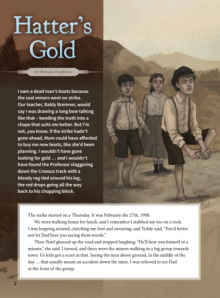
Hatter’s Gold
by Renata Hopkins
illustrations by Matt Haworth
This historical fiction story is set in the West Coast mining town of Blackball in the early 1900s. Laurie, a twelve-year-old boy whose father is a coal miner, tells the story. When the miners go on strike, Laurie realises his family won’t be able to afford the new boots he needs. Laurie sets off to find some gold. Instead he finds a fatally injured old miner (a “hatter”) who opens up the possibility that there are more options than mining.
-
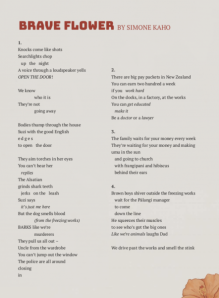
Brave Flower
by Simone Kaho
illustrated by Leilani Isara
The poem “Brave Flower” vividly captures the experience of those who were subjected to the dawn raids that took place in Aotearoa in the 1970's.
-
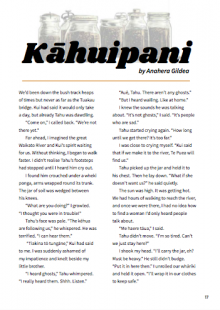
Kāhuipani
by Anahera Gildea
illustrated by Andrew Burdan
Based on a true story, Kāhuipani details the journey of two children to the Tuakau bridge to find Te Puea, a young woman who cared for more than 100 orphans during the influenza epidemic of 1918.
-
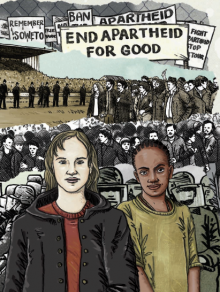
Mirror Image
by Julia Randerson
illustrated by Peter Campbell
Winner of the 2016 Elsie Locke Writing Prize
"Rain spat at Meggie as she trudged home through storm-darkened streets. Being mocked at school for opposing the Springbok tour had put her in a black mood."
-
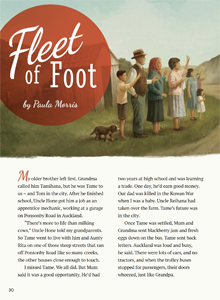
Fleet of Foot
by Paula Morris; illustrations by Andrew Burdan
The movement of Māori to the cities in the 1950s and 1960s was one of the most significant movements of people in our recent history. Paula Morris has used stories from her whānau as a basis for “Fleet of Foot”, a work of fiction that sits alongside “Kei Te Tāone Nui”, an article in the same journal that also explores the topic of Māori urbanisation. The text has links to the Aotearoa New Zealand’s histories curriculum.
-
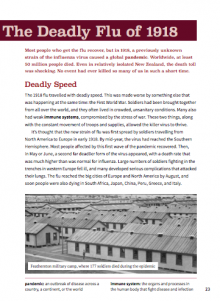
Pandemic: The Deadly Flu of 1918
by Renata Hopkins
Most students are aware of New Zealand’s participation in the First World War, but few will know of the flu pandemic that swept across the world in its aftermath. In New Zealand, the epidemic took over nine thousand lives in under two months – an appalling number, especially if compared with the eighteen thousand soldiers whose lives were lost to the war. This article conveys the horror of the event while imparting factual information about how the virus spread and how the government and communities tried to deal with it.
-

Designed for Good
by Philip Cleaver
The New Zealand environment has been badly affected by introduced pests such as rats, stoats, and possums. “Designed for Good” follows the process of developing an effective and humane trap to reduce these pest populations. The article tells the story of the project, from the first “That’s it!” moment through to the production of thousands of traps, which are now in use throughout New Zealand.
-
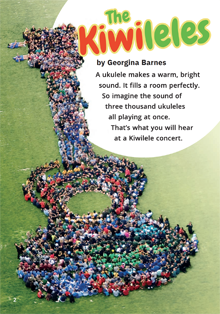
The Kiwileles
by Georgina Barnes
This report provides information about the Kiwileles, a ukulele orchestra made up of New Zealand school students. It focuses on the experiences of students at East Tamaki School and includes a description of some of the steps involved in learning to play a ukulele.
-
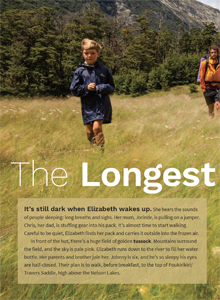
The Longest Walk
by Rebekah White
The Rapsey family, including nine-year-old Elizabeth and her six-year-old brother, Johnny, spent just over four months walking the entire length of New Zealand. During this time, they lived a simple life, learning about the natural world around them and the various ways to engage with it. Rebekah White captures both the sense of adventure and the contemplative moments through her lyrical style, which contains some elements of creative non-fiction.





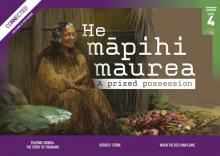
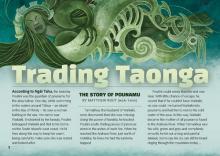

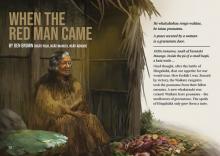

 Literacy Online home
Literacy Online home
